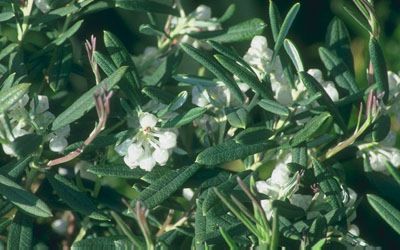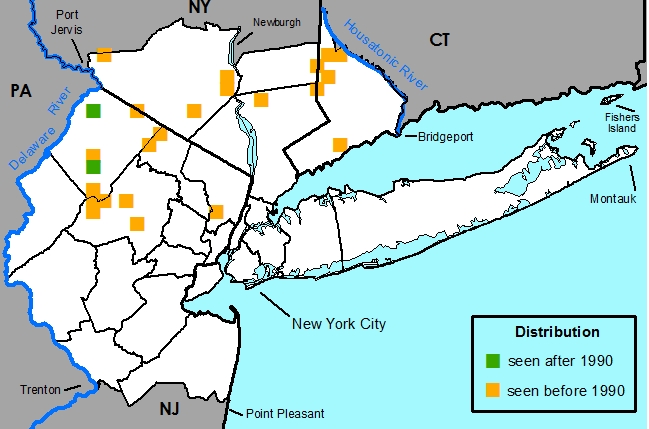Andromeda glaucophylla Link - Bog Rosemary

Bog Rosemary
Photo © Peter Nelson, 1991, taken at the Brooklyn Botanic Garden.
Common Names
Bog RosemaryField Identification
A shrub of boggy habitats with narrow revolute leaves and white urceolate flowers.Food uses
Disclaimer: The information provided here is for reference and historical use. We do not recommend nor do we condone the use of this species for food purposes without first consulting a physician.The leaves are the source of an aromatic tea used by the Ojibwa.
Poisonous properties
Disclaimer: The information provided here is for reference and historical use. If you believe you have been poisoned, please contact the Poison Control Office near you (look for the number in the front of the phone book).
Bog Rosemary contains andromedotoxin (grayanoside). See Kalmia latifolia for more detail about the poisonous properties.
Nomenclature
*Andromeda polifolia var. major C. F. Ludw., Neuere. Wilde Baumz. 3. 1783, nom. inval. (Art. 32.1c). TYPE: Type not cited, placed in synonymy here by (Rehder, 1949).*Andromeda polifolia var. minima C. F. Ludw., Neuere. Wilde Baumz. 3. 1783, nom. inval. (Art. 32.1c). TYPE: Type not cited, placed in synonymy here by (Rehder, 1949).
*Andromeda polifolia var. latifolia Aiton, Hort. Kew 2: 68. 1789. *Andromeda glaucophylla Link, Enum. Hort. Berol. Alt. 1: 394. 1822. *Andromeda polifolia var. glaucophylla (Link) DC., Prodr. 7(2): 607. 1839, nom. illeg. (Art. 52.1). *Polifolia montana var. glaucophylla (Link) Nakai, Trees Shrubs Japan 1: 155. 1922, nom. illeg. (Art. 52.1). *Polifolia montana var. latifolia (Aiton) Nakai, Trees Shrubs Japan 1: 156. 1922, nom. illeg. (Art. 52.1). *Andromeda glaucophylla f. latifolia (Aiton) Rehder, J. Arnold Arbor. 5: 55. 1924, nom. illeg. (Art. 52.1). *Andromeda glaucophylla var. latifolia (Aiton) Rehder, Man. Cult. Trees 709. 1927, nom. illeg. (Art. 52.1). *Andromeda polifolia ssp. glaucophylla (Link) Hultén, Acta Univ. Lund., N.F. Avd. 2. 44(1): 1242. 1948. TYPE: Canada. Newfoundland: Croque, Banks s.n. (Lectotype: BM, tracing GH!), selected by (Fernald, 1916). Rehder (Rehder, 1924) stated: "Link's description of his A. glaucophylla is apparently based on a plant cultivated in the Botanic Garden at Berlin." He goes on to speculate that if a specimen was made and deposited in the Berlin herbarium it would be the type. But Link also cites A. polifolia [beta] Pursh, which is a citation of A. polifolia var. latifolia Aiton. [broad leaves]
*Andromeda polifolia var. angustifolia Aiton, Hort. Kew. 2: 68. 1789. *Andromeda rosmarinifolia Pursh, Fl. Amer. Sept. 1: 291. 1814, nom. inval.? (Art. 34.1b). *A. polifolia var. rosmarinifolia (Pursh) Torr., Amer. J. Sci. Arts 4: 62. 1821, nom. illeg. (Art. 52.1). TYPE: Type not designated, probably two elements. [narrow leaves]
*Andromeda canescens Small, N. Amer. Fl. 29: 61. 1914. TYPE: United States. New York: Chilson Lake, 30 Aug 1900, N. L. Britton & E. G. Britton (Holotype: NY!). [pubescent?]
Nomenclatural Discussion
Andromeda rosmarinifolia Pursh may be the earliest legitimate name at the species level for this taxon. I am unsure whether this name is validly published. If this taxon is treated as a variety of A. polifolia then the earliest legitimate name is either A. polifolia var. latifolia Aiton or A. polifolia var. angustifolia. Since I have not found precedence for one over the other I cannot say which name is correct.
Clausen (Clausen, 1949) validated A. polifolia ssp. glaucophylla Hultén, writing: "This validation of Hultén's combination is necessary since he did not provide the bibliographic citation for the basionym." However, Art. 33.2 states that only after 1 Jan 1953 would Hultén's combination be invalid.
Description
HABIT perennial, evergreen, chamaephyte, shrubs, autotrophic, monoclinous, with adventitious roots or with fibrous roots, 0.15-0.35 m tall, not modified.STEMS ascending or erect, round, not winged, "regular". Prickles absent. Bark striate, exfoliating, dark gray. Branches erect or ascending, dark gray, round, not winged, 1.5-2 mm in diam. Twigs light orange-yellow or light yellowish orange, not odoriferous, ridged, 1-1.2 mm in diam., smooth, glabrous, without glands. Pith present, light orange-yellow or light yellowish orange, round, continuous. Thorns absent. Aerial roots absent. Sap translucent. Resin absent.
LEAVES alternate, 1 per node, spaced evenly along stem, divergent from stem, simple. Stipules absent. Leaves petiolate or leaves sessile (nearly so), petiole "typical", 0.15-0.2 cm long, glabrous, without glands. Leaf: abaxial surface dark bluish green, adaxial surface white or light bluish green, blades linear or narrowly elliptic or oblanceolate, revolute only at margin or revolute, symmetric, (1.5-)2.8-5 cm long, 0.2-1.5 cm wide, coriaceous, base cuneate, margin entire, apex acute, abaxial surface glabrous, without glands, adaxial surface hairs short and unbranched, erect or appressed or spreading, unicellular, uniseriate, white, dense, throughout except midveins, not glabrescent, without glands. Eucamptodromous venation, veins 7-14 (often obscure). Leaf lobes absent. Spines absent. Tendrils absent.
INFLORESCENCES monomorphic, regular or, if dimorphic, female inflorescence simple, nodding cormybose raceme, terminal. Peduncle present, 0.2-0.6 cm long. Rachis present, 0.2-0.4 cm long, with bracts. Bracts sessile, blades: abaxial surface green (sometimes reddish green), adaxial surface green, obovate, involute, 0.2-0.4 mm long, 0.1-0.2 mm wide, base truncate, margin entire, apex long acuminate, abaxial surface glabrous, without glands, adaxial surface glabrous, without glands. Pedicel 5-8 mm long, glabrous, without glands. Bracteoles 2, sessile, at base of pedicel, not connate, bracteoles: abaxial surface reddish orange, bracteole: adaxial surface reddish orange, rhombic, involute, 1.1-1.5 mm long, 0.7-1 mm wide, base truncate, margin entire or crispate, apex obtuse. Cupules absent.
FLOWERS serotinous, formed on short shoots, monomorphic, with sepals and petals readily distinguishable from one another, bisexual, flowers light red, 5-merous, 4.4-5 mm long, 2.5-3 mm wide, 4-6 flowers per inflorescence, perianth of two whorls. Calyx present, actinomorphic, of free sepals, persistent, abaxial and adaxial surfaces the same color, orange-red, 1-1.5 mm long, 2-3 mm wide. Sepals or sepal lobes 5, narrow oblong, 0.7-1.1 mm long, 1-1.6 mm wide, base truncate, margin entire, apex acute, abaxial surface glabrous, without glands, adaxial surface glabrous, without glands. Epicalyx absent. Corolla present, actinomorphic, urceolate, of fused petals, deciduous, abaxial and adaxial surfaces the same color, light red, uniform, (4-)4.5-5(-6) mm long, 2.5-3 mm wide, corolla limb 5-9 mm long, 1.1-1.5 mm wide. Petals or petal lobes 5, "normal", shallowly triangular, 0.5-0.7 mm long, 0.5-0.8 mm wide, base truncate, margin entire, apex acute, abaxial surface glabrous, without glands, adaxial surface glabrous, without glands. Gynoecium syncarpous. Carpels 5. Stigmas 1, capitate. Styles persistent, 1, 2-2.9 mm long. Ovary superior, 0.9-1.2 mm long, 1-1.1 mm wide, nectiferous disk present. Locules 5. Placentation apical axile. Androecium obdiplostemonous. Stamens 10, 1.5-2.5 mm long. Anthers oval, opening at a right angle to the long axis, opening 1/4 of entire anther, bithecal, yellowish orange, papillose, awned, awns 2, slender. Filaments free, straight, yellowish orange, hairs long and unbranched, erect, unicellular, uniseriate. Staminodes absent.
FRUITS septicidal capsule, dark blue or black, globose, 3.5-4.3 mm long, 4.5-5 mm wide, glabrous, without glands.
SEEDS many, yellowish orange or reddish orange, ovoid, 1.1-1.3 mm long, 0.7-0.8 mm wide, wingless, not tailed, smooth.
Habitat
(Gates, 1942) (Reschke, 1990) (Wherry, 1920)
Bogs, shrub swamps, and rarely in calcarious swales. Andromeda glaucophylla is a common plant in dwarf shrub bogs and inland poor fens, often associated with Chamaedaphne calyculata, Kalmia polifolia, Rhododendron groenlandicum, and Vaccinium oxycoccus. The soils are weakly minerotropic with a pH of 4.5-5.
Rarity Status
Heritage global rank -- G5Connecticut -- endangered
New Jersey -- endangered (Heritage rank: S1)
New York -- not listed
Species Biology
FloweringMay [weeks 1-4] (June [week 3]).
Pollination
(Hagerup, 1954) (Reader, 1975) (Reader, 1977) (Small, 1976)Autogamy -- Self-pollination is possible but usually not very effective; but see (Hagerup,1954) .
Melittophily -- Flowers are visited by a number of insects (but often few individuals), most commonly by Apis mellifera L., Bombus affinis Cr., B. fervida (F.), B. impatiens Cr., B. terricola Kby., B. vagans Sm., and Andrena spp.
Other -- Flies and butterflies are reported as floral visitors but probably do not pollinate the flowers.
Fruiting
(May [week 4]) June [week 2] - November [week 2].
Dispersal
Anemochory -- Probably wind.
Germination
(Young & Young, 1992)Germinable.